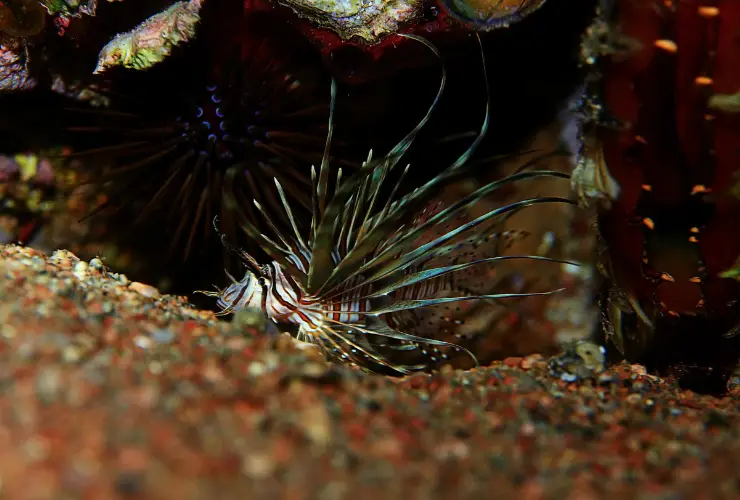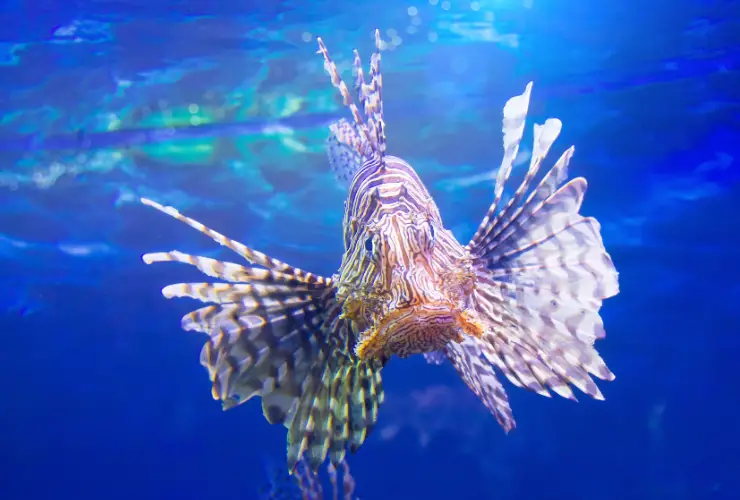Zebra Turkeyfish, also known as Zebra Lionfish, is a venomous marine fish species that belongs to the Scorpaenidae family. These fish are native to the Indo-Pacific region, inhabiting coral reefs and rocky areas. They are a well-known sight for divers and snorkelers because of their striking appearance, which includes bold stripes and long, flowing fins.
However, the Zebra Turkeyfish is not just a pretty face. These fish are both fascinating and dangerous because of their poisonous spines, which can deliver a potentially harmful sting. The spines on their dorsal, anal, and pelvic fins are used for self-defense and can inject venom into their prey or predators. The toxin is potent and can cause various symptoms, including pain, swelling, and nausea.
Despite their venomous nature, the Zebra Turkeyfish has fascinating biology and behavior. Read this blog to learn more about the world of the zebra Turkeyfish.

About Zebra Turkeyfish – A Quick Biology
Here’s a quick look at this fish species.
| Parameters | Details |
| Scientific name | Dendrochirus zebra |
| Kingdom | Animalia |
| Order | Scorpaeniformes |
| Class | Actinopterygii |
| Phylum | Chordata |
| Family | Scorpaenidae |
| Genus | Dendrochirus |
| Species | D. zebra |
| Habitat | Resides coral, rock bottoms on reef flats, outer reefs, and lagoons |
| Geography | West Indian Ocean, Australia, Japan, The Red Sea, East Indian Ocean |
| Lifespan | 10-15 years |
| Diet | small fish, shrimp, and crustaceans |
| Size | Max. 25 cm (9,8″) |
| Synonyms | Zebra lionfish, Zebra firefish, Many-spotted Butterfly-cod, Zebra Butterfly-cod |
Distribution (Where Do Zebra Turkeyfish Live?)
According to an article published in the Russian Journal of Marine Biology, the zebra lionfish can be found in many areas of the world, specifically in the tropical and subtropical zones.
You will find them between 30 degrees North and 30 degrees South and 32 degrees East and 163 degrees West.
The species’ range extends from the southern waters of Australia to the northern waters south of Japan. They can be found in locations such as:
- South Africa
- Madagascar
- Red Sea
- India
- Sri Lanka
- Philippines
- Palau
- Guam
- Fiji
- Samoa islands.
Habitat and Range
Typically residing on reef flats, outer reefs, and lagoons, the Zebra Turkeyfish is a bottom-dwelling species. They prefer coral, pebble, and rock bottoms. They inhabit sandy areas at depths ranging from 5 meters to 25 meters on reef tops. They can also be found in caves, occasionally in small clusters.

Physical Characteristics/Anatomy of Zebra Turkeyfish
The Zebra Turkeyfish is a unique fish that stands out for its unusual appearance. It can grow up to a maximum length of approximately 25 centimeters. Its body is distinctively elongated and flattened.
They are covered in orange, white, and black vertical stripes, hence “zebra.” The intricate and irregular lines give the fish an almost psychedelic, mesmerizing, and hypnotic appearance.
The fins of the Zebra Turkeyfish are also highly unique. While resting on the seabed, the Zebra Turkeyfish’s pectoral fins flex on each side, resembling large striped fans.
The front dorsal fin comprises 13 tall, quill-like spines, while the second dorsal fin comprises 10 to 11 soft rays. The anal fin contains 3 spines and almost 10 soft rays. The second dorsal fin, anal fin, and rounded caudal fin are marked with black/white bands.
Behavior
According to an article published in Marine Biology, zebra lionfish exhibit various behavioral adaptations which enable them to survive in their natural habitat. One prominent behavioral adaptation of the zebra lionfish is cooperative hunting.
They belong to gregarious behavior, which involves individuals hunting together to increase their chances of success.
This behavior suggests an aggregative tendency. It is particularly during rest behavior due to attraction for the same shelter characteristics. The species is a skilled predator, using its large fan-like pectoral fins to maneuver and control its movements. Pectoral fins are also allowing it to stalk and capture prey effectively.
It also has excellent eyesight and can detect even small movements in the water, enabling it to pounce quickly on prey. Additionally, the Zebra lionfish has venomous spines that it uses to immobilize its prey, making it easier to consume.
Feeding Habits/Diet- Are Zebra Lionfish Carnivores or Omnivores?
The zebra lionfish (Dendrochirus zebra) is a carnivorous marine fish that feeds on small fish, crustaceans, and other tiny marine organisms.
They are known for their unique feeding method, using their giant mouths to create a vacuum to suck in and swallow their prey whole. Combined with their sharp spines, this technique makes them efficient and deadly predators in their habitat.
Reproductive Cycle
The zebra lionfish is a sexually dimorphic species. It means males and females differ in appearance and reproductive strategies.
During courtship, the male Zebra Turkeyfish takes on the more aggressive role while the female transforms visually. As the male pursues the female, she develops a “white” face, which is thought to be a sign of receptiveness.
The Zebra Turkeyfish spawns at night, ascending quickly and briefly in pairs to reach the apex. They release a gelatinous mass containing between 2,000 and 15,000 eggs.
The eggs are released in open water, where males fertilize them. The fertilized eggs are pelagic and hatch into larvae after 36-48 hours. Larvae settle out in some weeks when they reach 10 to 12 millimeters. (Source)
Growth
According to another article published in the Journal of Ichthyology, the larvae of zebra Turkeyfish are planktonic and feed on other small planktonic organisms such as copepods and rotifers.
As they develop, they undergo a metamorphosis involving spines growth and the formation of the characteristic lionfish shape. After a few weeks of pelagic life, the larvae will settle onto the reef and develop into juveniles.
This metamorphosis also includes a shift in diet from small planktonic organisms to larger prey such as fish and crustaceans. Juveniles are generally not as vulnerable to predation as larvae. However, they can still be preyed upon by larger fish.
As the zebra lionfish continues to grow and mature, it will eventually reach sexual maturity, typically when they are between 1 to 2 years old. Females usually give birth once every three years and remain reproductively active until their 24th year.
The gestation period is approximately 21 to 28 days, and the female will give birth to live young. The number of offspring per brood can vary but typically ranges from 100 to 150.
Ecosystem Effects
Zebra Turkeyfish is an invasive species. When introduced to a new ecosystem, they can rapidly reproduce and spread, leading to declines in the populations of native species.
This can have a cascading effect on the entire ecosystem. The loss of these species can impact the food chain and alter the physical structure of the habitat.
Additionally, zebra lionfish are venomous, which means they can deter native predators. This can increase the populations of other prey species, further altering the ecosystem.
Predators – Who Eats Zebra Turkeyfish?
Several natural predators within the Indo-Pacific and Red Sea are known to prey on zebra lionfish. These include sharks, cornetfish, grouper, eels, frogfish, and scorpionfish. While it is speculated that some species of snapper and triggerfish may also eat lionfish in their native ranges, further research is needed to confirm this.
Relationship with Humans
The relationship between zebra lionfish and humans is complex and multifaceted. On the one hand, these fish are often kept in home aquariums and are admired for their unique and striking appearance. They are relatively easy to care for and have become a common addition to many home aquariums.
However, their popularity in the trade has also led to unintentional introductions into non-native habitats, where they can become invasive. They can also have negative impacts on marine ecosystems and human activities.

Can You Eat Zebra Turkeyfish?
Although zebra Turkeyfish can be harvested for human consumption, they are not commonly eaten due to the potential risks associated with their venomous spines.
However, if the fish is carefully and skillfully prepared, the flesh is reportedly tasty and can be consumed. Some chefs and food enthusiasts have started promoting the consumption of zebra Turkeyfish to control their populations and reduce their impact on marine ecosystems.
Are Zebra Turkey Fish Venomous?
Zebra Turkeyfish (Dendrochirus zebra) are venomous. They belong to the scorpionfish family, which is known for its venomous spines. Zebra Turkeyfish has 13 venomous spines along their back, which they use for self-defense.
Their venom is not considered to be lethal to humans. Still, it can cause severe pain, swelling, and even paralysis if you accidentally step on one or touch one that is hidden. Therefore, you should handle these fish carefully and avoid contact with their spines.
FAQs
What happens if you get stung by a Zebra Turkeyfish?
If you happen to get stung by a Zebra Turkeyfish, it can result in some severe symptoms. The chances of developing an infection and experiencing widespread effects such as:
- Changes in heart rate
- Abdominal pain
- Shivering and fainting are doubled after being stung by this fish.
Although it’s rare, Zebra Turkeyfish stings can potentially be fatal. Depending on the severity of the sting, symptoms may persist for anywhere from 8 hours to 30 days.
Are Zebra Turkeyfish endangered?
The status of Zebra Turkeyfish is not well-known, and there is limited information on their current population size and trends. However, the IUCN has not listed the species as endangered or threatened.
How Rare is a Zebra Turkeyfish?
While there is no definitive data on the exact population size of Dendrochirus zebra, it is considered a relatively common species in its native range. In fact, it is often encountered by divers and snorkelers. The aquarium trade sometimes targets it due to its striking appearance.
Conclusion
Zebra Turkeyfish is a stunning and fascinating species that can make a great addition to a well-maintained and appropriately-sized saltwater aquarium.
Its bold black and white stripes and elongated fins make it a visually striking fish that can become a centerpiece in any aquarium.
The zebra lionfish is also an invasive species in some areas, including the Atlantic Ocean and the Mediterranean Sea. It can disrupt the natural ecosystem and prey on native species. As such, it’s crucial for aquarium owners to never release these fish into the wild and only to acquire them from reputable sources.
But that is not all! Do you know Zebra Turkeyfish are not highly active and tend to remain in one place? Due to their relatively inactive lifestyle, marine organisms, including algae, tend to grow on their skin. These fish possess a thin external skin layer that regularly sheds to prevent excessive growth.
